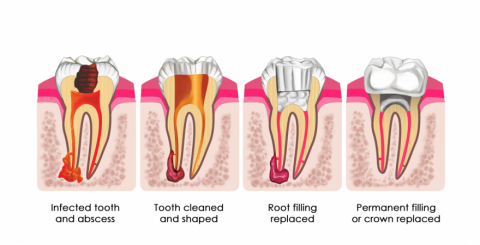Stages of Root Canal Treatment

If you’ve been advised to go for root canal treatment and if this is your first time, you could be nervous. Being informed about what root canal treatment is all about, makes you better prepared and less anxious.
Root canal treatment becomes necessary when the tooth pulp becomes inflamed or infected, leading to severe tooth pain and, eventually, damaging the pulp. Root canal treatment saves the tooth and relieves the pain.
The causes for a root canal could be deep tooth decay, repeated dental procedures on one tooth, trauma such as a crack, chip, or even a root fracture. Sometimes gum disease can also lead to root canal problems necessitating root canal treatment.
Root canal treatment is done in the following steps:
Step 1 – Diagnosis, preparation of the infected site, and rubber dam application - Your dentist will assess the cause for tooth pain after evaluating your medical history and examining the tooth with a radiographic image (X-ray) of the tooth.
Step 2 – Local anesthesia is administered via injections to numb the tooth to be treated and the surrounding tissues. If you are very nervous about the pain, your dentist will use oral sedation to keep you calm during the treatment.
Step 3 – A rubber dam is applied to isolate the infected tooth: This helps the dentist to better access and view the tooth and prevent contamination from the bacteria in the saliva or rest of the mouth.
Step 4 – Accessing the root canal: The root canal is accessed by making a hole in the crown to access the pulp chamber and root canal for treatment. If the back tooth is infected, a hole is made through the biting surface of that affected tooth; if it is the front tooth, the hole is made from behind the tooth to access the pulp chamber.
Step 5 - Cleaning the root canal: The canal is shaped to carry out the disinfection by irrigating the canal. The infected pulp tissue and the damaged nerve are then removed from the root canal. Irrigation of canal disinfects the canal and the pulp chamber with a disinfecting solution.
Step 6 – Shaping the canals: The canals are then shaped with tiny flexible instruments to allow them to receive root canal fillings and sealers.
Step 7 - Sealing the tooth: The cleaned canal is then packed with sealing material called gutta-percha, a biocompatible material. This prevents the entry of microbes and future infections.
Step 8 – Sealing the access hole: A temporary or permanent filling material is placed to seal the access hole (that was made to treat the canals). If the tooth lacks sufficient structure to hold a restoration (filling) in place, a metal post may be placed in one of the canals inside the tooth to help retain it.
Step 9 – Post RCT care: After the procedure, an antibiotic and pain medication may be prescribed to treat or prevent infection and manage pain, if any. Follow the instructions of your dentist or endodontist.
Step 10 – Restoration - Your tooth will need a permanent restoration to replace the lost tooth structure and provide a complete seal to the top of the tooth. The restoration could be a filling or a crown. If you’ve been advised root canal treatment and if this is your first time, you could be apprehensive. Being informed about what root canal treatment is all about, makes you better prepared and less apprehensive.
These are the stages for root canal treatment. If your tooth pulp is infected, then do for root canal treatment. Take the correct medication after the root canal treatment. so that it will cure easily.
Treating root canals require a great deal of precision and care to treat well. Therefore, some of the dentists use state-of-the-art technology including digital (radiographic) imaging to diagnose root canal problems. They use ultrasonic instrumentation to remove old canal fillings and posts and clean canals; and operating microscopes to accurately locate, visualize and seal root canal systems
The whole treatment is quite high-tech and requires highly skilled dentists or endodontists to perform root canal treatment successfully. The dentists who are empathetic and therefore use oral sedation to allay any fear of treatment for the patient.
Similar Articles
Teeth and gums form a complex system that functions daily and continuously. We often underestimate their importance until pain, sensitivity, or other unpleasant symptoms arise.
You take a sip of iced water, and suddenly, one tooth lights up with a sharp sting. That quick shock is more than annoying; it can change what you eat, how you drink, and even how you breathe in cold air.
In the past, correcting misaligned teeth meant committing to years of highly visible metal braces, diet restrictions, and frequent, sometimes uncomfortable, adjustments
Baby teeth can cause a lot of worry for parents, especially when things do not seem to happen on
Ever caught yourself hiding behind your hand during a good laugh? Or dodging the camera at family gatherings? Those small chips, stubborn stains, or awkward gaps in your teeth can chip away at your confidence year after year.
When most people think about straightening their teeth, they envision traditional metal braces. However, because of recent advances in orthodontics, there are now more discreet, pleasant, and efficient solutions available.
Healthy gums not only ensure a beautiful smile but are also essential for overall oral health. However, conditions often arise that require surgical intervention in addition to dental treatment.
A tight booking calendar, a last-minute casting call, and a grin that has to look flawless by Friday—life as a Harlem creative rarely leaves space for dental upgrades
Gingivitis is an inflammation of the gums caused by the accumulation of plaque and bacteria.









